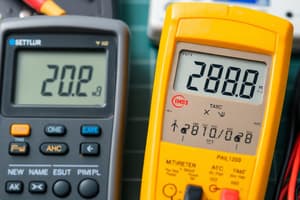Podcast
Questions and Answers
What is the 200 milliamps (mA) range suitable for?
What is the 200 milliamps (mA) range suitable for?
- Measuring high voltage circuits
- Measuring small circuits or batteries (correct)
- Measuring resistors
- Measuring temperature
What type of measurements is the 20mA range typically used for?
What type of measurements is the 20mA range typically used for?
- Voltage measurements
- Current measurements ranging from 0 to 20 milliamperes (correct)
- Temperature measurements
- Resistance measurements
Why is the 200mV range not suitable for current measurements?
Why is the 200mV range not suitable for current measurements?
- It measures millivolt drops across a 1 ohm resistor (correct)
- It can measure currents up to 20 mA
- It is used for measuring high current circuits
- It offers relatively high accuracy
Which current range is sometimes labeled as T20 or Ia?
Which current range is sometimes labeled as T20 or Ia?
What does a reading of 0.8 mA on the 200mA range indicate?
What does a reading of 0.8 mA on the 200mA range indicate?
Which range should you consult the manufacturer's specifications before using?
Which range should you consult the manufacturer's specifications before using?
What is the most common current range used in a digital multimeter?
What is the most common current range used in a digital multimeter?
When measuring current with a digital multimeter, what can over-ranging lead to?
When measuring current with a digital multimeter, what can over-ranging lead to?
What should you do before measuring current to ensure safe operation?
What should you do before measuring current to ensure safe operation?
Which is a precaution to prevent electrical shock when using a digital multimeter?
Which is a precaution to prevent electrical shock when using a digital multimeter?
What damage can under-ranging lead to when measuring current with a digital multimeter?
What damage can under-ranging lead to when measuring current with a digital multimeter?
Why is selecting the correct current range important when using a digital multimeter?
Why is selecting the correct current range important when using a digital multimeter?
Study Notes
Current Measurement Using a Digital Multimeter (DMM)
A digital multimeter (DMM) is a versatile tool used for measuring electrical parameters such as voltage, resistance, and current. It provides accurate readings and is highly durable due to its electronic components. When it comes to measuring current with a DMM, there are several aspects you need to consider, including range selection and safety precautions.
Ranges of Current Measurement
Digital multimeters offer various current ranges to accommodate different types of circuits and applications. These ranges can usually be found under the "DC Current" section when selecting the test function. Commonly offered ranges include:
200mA
The 200 milliamps (mA) range is suitable for small circuits or batteries. For example, if you measure a battery with this setting, your reading will show something like 0.8 mA, indicating an actual value between 0 and 1 mA. This range is considered safe for most general work, but always consult the manufacturer's specifications before proceeding.
20mA
Sometimes labeled as T20 or Ia, this range is less precise but more sensitive than the other ranges. It is typically used for current measurements ranging from 0 to 20 milliamperes.
200mV
Also known as the 200 millivolts range, this option offers relatively high accuracy. However, since it measures millivolt drops across a 1 ohm resistor, it is not suitable for current measurements. It is typically used for sensitive measurements like low ohm resistances or small voltages.
200mA, 100mA, 50mA, 20mA, 10mA, and 1mA
These ranges are for measuring higher currents. The 200mA range is the most common, and it can measure up to 200 milliamperes. The other ranges are less common and are typically used for specific applications where the higher precision of the 200mA range is not necessary.
Safety Precautions
When using a digital multimeter for current measurement, safety is paramount. Here are some guidelines to ensure safe operation:
-
Turn off the multimeter when not in use: This is a general rule for any electronic device to prevent accidental activation and save battery life.
-
Select the correct range: Always choose the appropriate range for your measurements to avoid damage to the multimeter or risking your safety. Under-ranging can lead to inaccurate readings, while over-ranging can cause damage to the multimeter or even personal harm.
-
Check for continuity: Before measuring current, ensure the circuit has continuity. Disconnecting the multimeter's test leads from the circuit after current measurement can prevent damage to the multimeter.
-
Avoid touching the multimeter's test leads with your bare hands: To prevent electrical shock, always handle the multimeter's test leads with insulated tools or protect your hands with gloves.
-
Check for voltage: Before measuring current, ensure the circuit is powered down or unplugged to avoid electrical shock.
-
Use a fused test lead: A fused test lead helps protect the multimeter in case of a short circuit, preventing damage to the device.
By following these safety precautions and understanding the various current ranges available on a digital multimeter, you can confidently measure current and make accurate measurements for your electrical projects.
Studying That Suits You
Use AI to generate personalized quizzes and flashcards to suit your learning preferences.
Description
Test your knowledge on measuring electrical current using a Digital Multimeter (DMM) with this quiz. Learn about different current ranges, safety precautions, and best practices to ensure accurate and safe measurements for your electrical projects.




